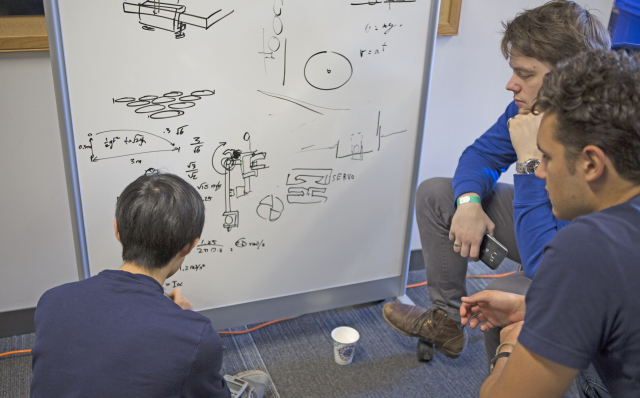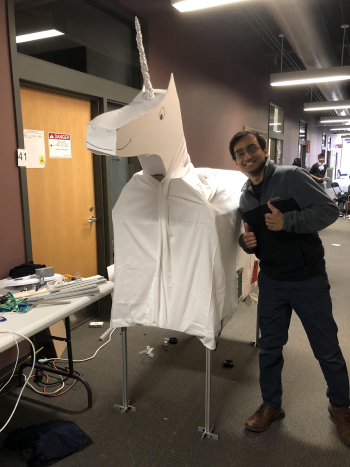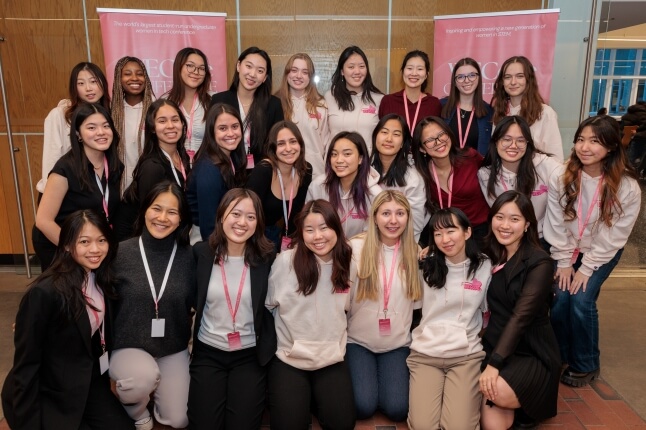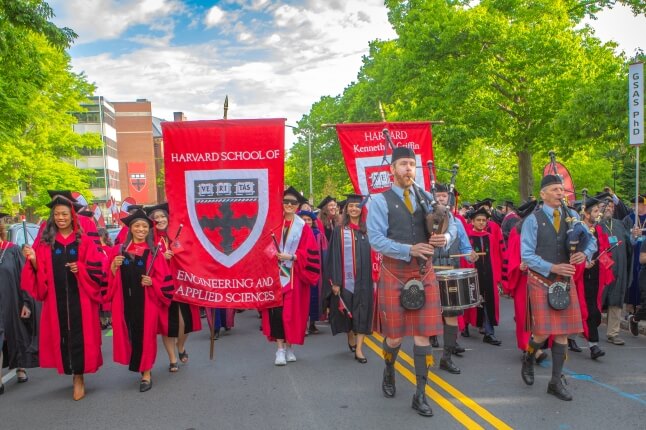News
During the MakeHarvard hackathon, two students from the University of Toronto work on a mobile carrier for a smart phone device in the Active Learning Labs. (Photo by Alana Davitt/SEAS Communications)
More than two hundred students were presented with hundreds of pounds of materials, dozens of workstations scattered throughout Pierce Hall and the Maxwell Dworkin building, soldering irons, voltmeters, electrical parts, bolts, screws, drills, and more, with only one objective: to make stuff.
This was the scene in the University’s engineering buildings over the weekend of Feb. 3 and 4 at the MakeHarvard Engineering Hackathon. The inaugural event, hosted by the John A. Paulson School of Engineering and Applied Sciences (SEAS), was inspired in part by a computer science hackathon students organized this fall.
Vivian Qiang, S.B. ’20, an electrical engineering concentrator and one of the coordinators of the event, explained: “The program started as a joint proposal between the organizing team of HackHarvard last semester and the board members of the Harvard Engineering Society. We reached out to sponsors, publicized the event on an international Hackathon Facebook group as well as through college email lists, and now we’re here.”
The leadership team consisted of 15 SEAS students, as well as the engineering experts on staff in the Active Learning Labs. Participants included engineering students from across the country and the world.

Dennis Zhang, S.B. ’18, a mechanical engineering concentrator, does some initial hand calculations for his team’s robotic throwing arm. (Photo by Alana Davitt/SEAS Communications)
A group from Northeastern University worked on a 3D maze where a player can remotely control how a platform moves to advance a ball through the course. On the floor below, a team from the University of Toronto pieced together the body and wheels for a mobile smart phone carrier, described as way to make Siri or Alexa come to you.
After the welcome ceremony and lab safety trainings on Saturday morning, the teams of makers were given 24 hours to design, construct, and code their creations. Inspiration often came from the long list of categories established by MakeHarvard staff for judging and prizes. One award category, “Most likely to become a unicorn,” which is a term for a successful startup, inspired chemistry and physics concentrator Vaibhav Mohanty, A.B./A.M. ’19, and his friends to construct an actual robotic unicorn they aptly named Startup.
 “Another category was for a device that helps you transition through a major life event. Our robot will get you through college,” explained Mohanty.
“Another category was for a device that helps you transition through a major life event. Our robot will get you through college,” explained Mohanty.
Their design included two doors that open upon voice command; one provides access to snacks, the other offers cleaning supplies.
The MakeHarvard Hackathon brought students together purely for the sake of being creative and having fun. Dixon Yang, a teaching assistant at Harvard, joined a team hoping to make a musical cat.
“We figured it has to be cute, and after looking at winners of past hackathons, music always wins. It’s true that winners get prizes, but it’s really all about play,” he said.
Other students came just to have easy access to so many tools.
“We’re mostly making small devices for our rooms and parts for our bikes,” explained Gunnar Plunkett, A.B. ’20, a computer science concentrator.
On the other hand, electrical engineering concentrator Austin Sams, S.B. ’19, was inspired by a class he took on microelectromechanical systems. Sams helped build an 11,000-rpm centrifuge out of laser cut acrylic, 3D printed materials, and a motor.
“It came from the ‘lab in a test-tube’ idea, but to get results we needed a way to move the liquid,” he said.
By Sunday afternoon, most students’ endeavors were complete. The judges—representatives from some of the many corporate sponsors—presented prizes for the most innovative and well-designed projects.
Students departed with the reward of achievement and working among others who share in their passions.
Topics: Events
Cutting-edge science delivered direct to your inbox.
Join the Harvard SEAS mailing list.
Press Contact
Adam Zewe | 617-496-5878 | azewe@seas.harvard.edu



